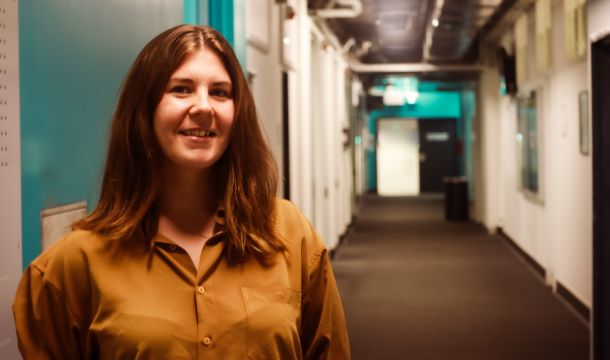Better than rocket science
She began with dreams of being an astrophysicist; now Amanda Seedhouse is working on the moonshot of quantum computing.

GROWING UP in a small town in England, Amanda Seedhouse, a Sydney Quantum Academy scholarship recipient, was inspired by her physics teacher to join an after-school science club. So began a journey that’s landed her on the frontline of an audacious mission.
As a PhD student at UNSW, she’s gained invaluable experience which has led to a role at Diraq, a university spin-off company led by her PhD supervisor Professor Andrew Dzurak. Diraq has a daring ambition: to put billions of qubits (the building blocks of a quantum computer) on a single computer chip.
“It’s a huge challenge!” she said. “I’m working on one little part of it, but it’s a crucial one – how to get the coherence times to be long enough so we can do important operations that the people developing computing algorithms need.
“Sometimes I think maybe it’s an engineering problem, but then I talk to the engineers here and find it’s often a tricky physics problem as well. The fact there’s noise in qubits gives me interesting problems to solve. I’m just excited I get to do really cool physics every day.”
Originally from the outskirts of London, she grew up in a small town in Wiltshire – within driving distance of Stonehenge – and had been interested in maths from an early age. But it wasn’t until high school that she became fired up “by a really cool physics teacher” to think of maths as a tool to explore and understand the world. “He would do these fun experiments, get us solving problems, and I’d see how maths is in everything.”

She joined an after-school science club, learned to solder “and just kind of messed around, did silly experiments”. Another influence was an inspiring maths teacher who showed her how a parallelepiped – basically a 3D parallelogram – could be sliced into six tetrahedrons. She was so entranced she baked a parallelepiped-shaped cake and tried to figure out how to correctly slice it using the mathematical proof she’d learned.
“That was fun. You prove the math, and then you see the result physically,” she recalled.
She had wanted to study astrophysics but, falling short of the grades needed, did an undergraduate physics degree and then a master’s at Cardiff University in Wales instead. She landed a research position working with a theoretical physicist and was soon deep in the brambles exploring states of matter at the quantum level.
For her master’s, she explored the spin relaxation of a muon, an elementary particle like an electron, but with a much greater mass. Later, she modelled the electric potential of a point charge, studying its resonance states. “It was all super interesting, but I was more interested in the theory behind it than how they related to physical things.”
"SQA has been fantastic – it’s this whole organisation focused on the students and trying to get academia and industry to work together in quantum,” she said. “We [the students] meet all the time for seminars to hear what everyone’s up to, and we go on hikes or to the beach together – it really gets you out of your university or research team bubble.”
Amanda Seedhouse
The move to Australia
Migrating to Adelaide in Australia with her parents in 2018, she decided to look up people she knew in Sydney – and by chance connected with researchers at UNSW Sydney, who just happened to be looking for someone with a theoretical bent and her kind of experience. And through the research group, she landed an SQA Supplementary Scholarship to do her PhD at UNSW.
“SQA has been fantastic – it’s this whole organisation focused on the students and trying to get academia and industry to work together in quantum,” she said. “We [the students] meet all the time for seminars to hear what everyone’s up to, and we go on hikes or to the beach together – it really gets you out of your university or research team bubble.”
Seedhouse submitted her PhD in May this year and now spends her days modelling spin qubits in silicon quantum dots – Diraq’s core technology – analysing how noise affects qubits and exploring how to remove that noise. “Noise is a huge problem in quantum computing; so, it feels like I’m right at the centre of it all,” she smiled.
– Wilson da Silva
Quantum research at UNSW Sydney
UNSW Sydney undertakes world-leading research in quantum technologies in both its School of Physics and School of Electrical Engineering and Telecommunications. It hosts the headquarters of ARC Centre of Excellence for Quantum Computation and Communication Technology (CQC2T) and two quantum spin-outs Diraq and Silicon Quantum Computing (SQC). Researchers at UNSW, Diraq and SQC are leading the world in the race to build silicon-based quantum computers. The University also hosts the headquarters of the NSW node of the Australian National Fabrication Facility which provides advanced nanofabrication capabilities needed for quantum device development.
Want to pursue a quantum PhD?
Check out our PhD scholarships now to see if you're eligible for funding. You could study with world-leading experts at one of our partner universities including the University of Sydney, UNSW, UTS and Macquarie University.